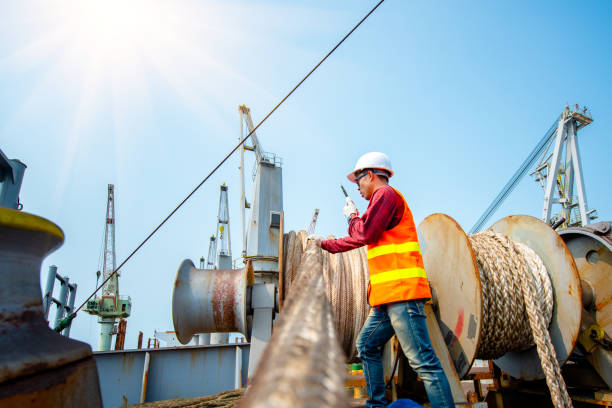List of Seafarer Positions: Deck and Engine

Throughout history, seafarers have played a pivotal role in shaping the course of human civilization. From the intrepid explorers who charted new territories to the skilled sailors who facilitated trade and commerce across distant seas, their voyages have connected continents, cultures, and economies.

Captain (Master):
- Description: The Captain, or Master, is the highest-ranking officer on board and is responsible for the overall operation and safety of the vessel. They make strategic decisions regarding navigation, cargo operations, and crew management, ensuring compliance with maritime regulations and company policies.
Page Contents
Brief History
Ancient mariners navigated by the stars, braving treacherous waters in search of knowledge, wealth, and adventure. The Age of Exploration saw European sailors venture into uncharted waters, discovering new lands and establishing global trade routes. Over time, advancements in technology transformed seafaring, from the invention of the compass to the development of steam-powered ships and navigation systems. Today, seafarers continue to navigate the world’s oceans, transporting goods, fueling economic growth, and fostering cultural exchange in an ever-changing maritime landscape. Their legacy is one of resilience, ingenuity, and the enduring spirit of adventure on the high seas.
List of Seafarer Positions: Deck and Engine
| DECK DEPT | ENGINE DEPT |
| DECK CREW: | ENGINE CREW: |
| Deckhand/Ordinary Seaman (OS) | Motorman/Wiper |
| Bosun (Boatswain) | Oiler/Greaser |
| Able Seaman (AB) | Electrician |
| Watchman/Security Officer: | Filters/ Mechanics |
| Radio Officer/Communications Officer | Wiper |
| Steward/Stewardess | Engine Cadets |
| Deck Cadet | |
| Quartermaster Steward/ Messman | |
| Chief Cook (Head Chef): Assistant Cook Dishwasher/ Galley Assistant | |
| DECK OFFICERS | ENGINE OFFICERS |
| Captain/ Master Mariner Chief Mate 2nd Mate 3rd mate | Chief Engineer 2nd Engineer 3rd Engineer 4th Engineer |
Below is a list of various seafarer positions categorized into deck crew, engine crew, and officers, along with descriptions of each role:
Deck Crew:
- Deckhand/Ordinary Seaman (OS):
- Description: Deckhands assist in the general maintenance and operation of the vessel’s deck and equipment. They handle mooring lines, perform lookout duties, and assist in cargo handling operations.
- Bosun (Boatswain):
- Description: The bosun oversees the deck crew and ensures that all deck operations are conducted safely and efficiently. They supervise the maintenance of deck equipment, oversee cargo loading and unloading, and manage the deck crew’s duties.
- Able Seaman (AB):
- Description: Able Seamen perform a variety of skilled deck operations, including navigation, steering the vessel, and maintaining deck equipment. They assist in mooring and anchoring procedures, handle cargo, and stand watch.
- Deck Officer (Mate):
- Description: Deck Officers, also known as Mates, assist the Captain in navigating and operating the vessel. They are responsible for maintaining navigational charts, supervising the deck crew, and ensuring compliance with safety regulations.
- Steward/Stewardess:
- Description: Stewards (or Stewardesses) are responsible for providing hospitality services aboard the vessel. They manage the ship’s mess, assist with food and beverage service, and ensure the cleanliness and comfort of passenger and crew accommodations.
- Deck Cadet:
- Description: Deck Cadets are trainees preparing to become licensed deck officers. They undergo practical training and academic studies to develop skills in navigation, seamanship, and ship operations under the supervision of experienced officers.
- Watchman/Security Officer:
- Description: The Watchman, also known as the Security Officer, is responsible for security duties aboard the vessel, including monitoring for unauthorized access, conducting patrols, and ensuring the safety of the crew and vessel during non-operational hours.
- Radio Officer/Communications Officer:
- Description: The Radio Officer, or Communications Officer, manages all radio communications on board the vessel. They are responsible for maintaining communication equipment, sending and receiving messages, and ensuring compliance with maritime communication regulations.
- Ordinary Seaman (OS):
- Description: Ordinary Seamen assist in the general maintenance and operation of the vessel’s deck and equipment. They handle mooring lines, perform lookout duties, assist in cargo handling operations, and carry out various tasks as directed by senior deck crew members.
- Chief Cook (Head Chef):
- Description: The Chief Cook, or Head Chef, is responsible for managing the ship’s galley and preparing meals for the crew and passengers. They plan menus, order provisions, supervise kitchen staff, and ensure food safety and hygiene standards are maintained.
- Assistant Cook:
- Description: Assistant Cooks assist the Chief Cook in meal preparation and kitchen operations. They help with cooking, baking, and food service tasks, as well as cleaning and maintaining kitchen equipment and facilities.
- Dishwasher/Galley Assistant:
- Description: Dishwashers (or Galley Assistants) are responsible for cleaning dishes, utensils, and kitchen equipment used during meal preparation and service. They assist in maintaining cleanliness and order in the galley and may also help with food preparation tasks as needed.
- Quartermaster
Description: The Quartermaster standing watch as assistant to deck officers and navigators. Serves as helmsman that includes ship control, navigation and detect errors in the navigational charts and out rightly corrects it..
Deck Officers
14. Third Mate (Third Officer):
- Description: The Third Mate, or Third Officer, assists in navigating and operating the vessel. They maintain navigational charts, assist with watchkeeping duties, and oversee safety procedures, cargo operations, and deck maintenance tasks.
15. Second Mate (Second Officer):
- Description: The Second Mate, or Second Officer, assists the Captain and Chief Mate in navigating and operating the vessel. They maintain navigational equipment, supervise watchkeeping duties, and ensure compliance with maritime regulations and safety procedures.
16. Chief Mate (First Mate):
- Description: The Chief Mate, or First Mate, is the second-in-command of the vessel and assists the Captain in all aspects of vessel operation. They oversee deck operations, cargo handling, and safety procedures, and may assume command in the Captain’s absence.
17. Captain (Master):
- Description: The Captain, or Master, is the highest-ranking officer on board and is responsible for the overall operation and safety of the vessel. They make strategic decisions regarding navigation, cargo operations, and crew management, ensuring compliance with maritime regulations and company policies.
Engine Crew:
1. Motorman/Wiper:
- Description: Motormen (or Wipers) are responsible for the general maintenance and cleanliness of the vessel’s engine room. They assist engineers in maintaining engine components, performing lubrication tasks, and ensuring the smooth operation of machinery.
2. Oiler/Greaser:
- Description: Oilers (or Greasers) are responsible for lubricating machinery and equipment in the engine room. They ensure that all moving parts receive adequate lubrication to prevent wear and maintain optimal performance.
3. Engine Room Officer (Engineer):
- Description: Engine Room Officers, also known as Engineers, are responsible for overseeing the operation and maintenance of the vessel’s propulsion and auxiliary systems. They supervise the engine crew, troubleshoot mechanical issues, and ensure compliance with safety regulations.
4. Oiler:
- Description: Oilers are responsible for lubricating machinery and equipment in the engine room. They ensure that all moving parts receive adequate lubrication to prevent wear and maintain optimal performance.
5. Electrician:
- Description: Electricians are responsible for maintaining and repairing electrical systems and equipment on board the vessel. They troubleshoot electrical issues, perform routine maintenance tasks, and ensure compliance with safety standards.
6. Fitters/Mechanics:
- Description: Fitters (or Mechanics) are skilled technicians responsible for maintaining and repairing mechanical systems and equipment in the engine room. They troubleshoot mechanical issues, perform routine maintenance tasks, and assist engineers in overhauling machinery.
7. Engine Cadet:
- Description: Engine Cadets undergo training to become licensed engineering officers. They assist the engineering team in maintaining and operating the vessel’s propulsion and auxiliary systems, performing routine maintenance tasks, and learning about engine operations.
Officers:
- Captain (Master):
- Description: The Captain, or Master, is the highest-ranking officer on board and is responsible for the overall operation and safety of the vessel. They make strategic decisions regarding navigation, cargo operations, and crew management, ensuring compliance with maritime regulations and company policies.
- Chief Officer (Chief Mate):
- Description: The Chief Officer, or Chief Mate, assists the Captain in navigating and operating the vessel. They oversee deck operations, cargo handling, and safety procedures, and may assume command in the Captain’s absence.
- Second Officer (Second Mate):
- Description: The Second Officer, or Second Mate, assists the Captain and Chief Officer in navigation and deck operations. They maintain navigational charts, assist with watchkeeping duties, and oversee safety drills and inspections.
- Chief Engineer:
- Description: The Chief Engineer is responsible for overseeing the operation and maintenance of the vessel’s propulsion and auxiliary systems. They manage the engineering team, supervise maintenance activities, and ensure the efficient operation of machinery.
Conclusion
Each of these positions TOGETHER plays a crucial role in ensuring the safe and efficient operation of a vessel at sea. Seafarers may progress through the ranks by gaining experience, completing training programs, and obtaining the necessary certifications and licenses.







